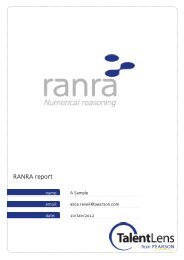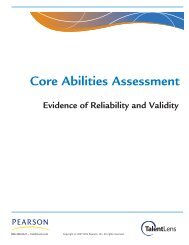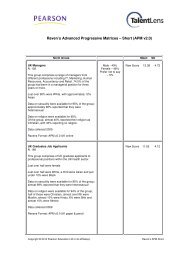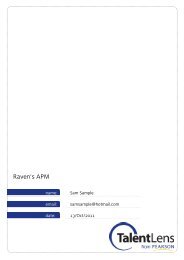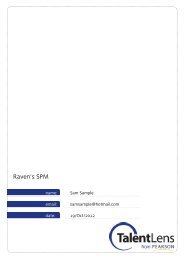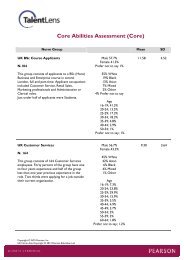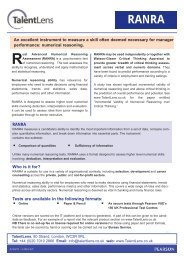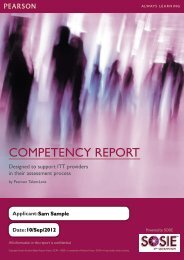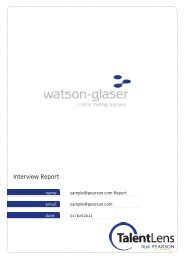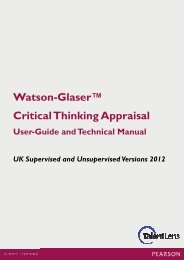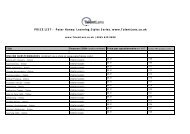Watson-Glaser (unsupervised) Development Report - TalentLens
Watson-Glaser (unsupervised) Development Report - TalentLens
Watson-Glaser (unsupervised) Development Report - TalentLens
Create successful ePaper yourself
Turn your PDF publications into a flip-book with our unique Google optimized e-Paper software.
Snapshot of Your Critical Thinking SkillsYour responses on the <strong>Watson</strong>-<strong>Glaser</strong> (Critical Thinking Appraisal Form) were compared to other individuals inyour profession. Based on this comparison, specific critical thinking skill areas are highlighted for yourdevelopment. A skill marked:• Strength to Leverage means you scored higher than most of your peers. You should make an effort toleverage this strength in your work.• Further Exploration means your score was average compared to your peers. You have some strengths inthis area, but you may not apply this skill consistently.• Opportunity for <strong>Development</strong> means you scored lower than most of your peers. You should devoteattention to building your proficiency in this area.Skill Area Strength to Leverage Further Exploration Opportunity for <strong>Development</strong>Recognise AssumptionsEvaluate ArgumentsDraw ConclusionsSkilled vs Unskilled BehavioursA brief description of each skill area and examples of skilled and unskilled behaviours are provided in thetable below to help you to understand your results.Critical Thinking Skilled Behaviours Unskilled BehavioursRecognise Assumptions:Assumptions are statements that are assumed to be true in theabsence of proof. Identifying them helps reveal information gaps andenrich perspectives on an issue.• Identifies what is being takenfor granted• Explores diverse viewpoints onissues• Proceeds on uncheckedassumptions• Reasons only from a singleviewpointEvaluate Arguments:Arguments are assertions that are intended to persuade someone tobelieve or act a certain way. Evaluating arguments is the process ofanalysing such assertions objectively and accurately.• Analyses an argument'sreasoning and supportingevidence thoroughly• Explores counterarguments,even when doing so iscontroversial• Fails to question the reasoningand supporting evidence foran argument• Moves forward withoutconsidering opposingargumentsDraw Conclusions:Drawing conclusions consists of arriving at conclusions that logicallyfollow from the available evidence.• Brings diverse informationtogether to come to anappropriate and reasonableconclusion• Changes a position when theevidence warrants doing so• Comes to a conclusion basedon limited or biasedinformation• Sticks to a position in spite ofcompelling evidencesupporting a differentconclusionnamesample test page 4©Pearson Education Ltd or its affiliate(s). All rights reserved. Adapted by permissionwww.talentlens.co.uksample@pearson.com - 27/Jul/2011 Assessment powered by Getfeedback © 2011
Recognise AssumptionsAssumptions are statements that are assumed to be true in the absence of proof. Identifying them helps to revealinformation gaps and enrich perspectives on an issue. Assumptions can be unstated or directly stated. Beingaware of these assumptions and directly assessing their appropriateness to a situation improves the quality andcomprehensiveness of critical thinking.YOUR RESULTSSkill Area Strength to Leverage Further Exploration Opportunity for <strong>Development</strong>Recognise AssumptionsYour score suggests that your skill in recognising assumptions is lower than your peers. Try to focus on buildingyour proficiency in this area. Guidance on improving this skill is provided on the next page.WHAT DOES YOUR SCORE MEAN?Your score suggests that you should more consistently and actively:• Identify what is assumed to be true in statements, arguments, or conclusions, and differentiate fact fromopinion.• Seek out different views of an issue as a way of bringing new assumptions to light. Since situations canchange based on the assumptions underlying them, this will promote better contingency planning,as well as a thorough consideration of alternative approaches to an issue.• Consider how appropriate different assumptions are for a situation.Personal ReflectionsHighlight the information under "What Does Your Score Mean?" that you think is most accurate. Where, when, andwith who have you exhibited these behaviours?namesample test page 5©Pearson Education Ltd or its affiliate(s). All rights reserved. Adapted by permissionwww.talentlens.co.uksample@pearson.com - 27/Jul/2011 Assessment powered by Getfeedback © 2011
HOW CAN YOU GROW YOUR SKILLS IN THIS AREA?• Ask basic questions to identify assumptions. Assumptions are rarely spelled out, so you will need to take extrasteps to identify them. Ask yourself, "What is being taken for granted?", "What do I expect to happen?",and "How do I know this is true?"• Consider your context. Assumptions are often made based on factors such as your personal background,previous experience, organisational norms, or cultural expectations. How do these factors influencewhat you are assuming?• Dig into the details. Assumptions might be based on different imagery (e.g. stereotypes vs. accuraterepresentations of a group) or different ways of framing an issue (e.g. crisis vs. opportunity). Change thewording, imagery, and framing around an issue to create new assumptions.• Engage others. Ask others to help you to challenge assumptions. Seek assistance from a diverse group -individuals from different divisions, organisations, industries, cultures, and/or geographies. Also, seekhelp from creative individuals who view issues differently or are good at highlighting unique elements ofa situation.• Evaluate the assumptions. Rate the quality of different assumptions. Start by identifying and listing theassumptions underlying each scenario, then explore whether each assumption is appropriate (e.g. howlikely is this assumption to hold for this situation?). Be sure to factor in the implications andconsequences of each (e.g. what if this assumption is wrong?)Personal ReflectionsRead the development suggestions above and check the ones that seem most useful to you. Where, when, andwith whom could you employ these suggestions?What other thoughts do you have about recognising assumptions?namepagesample test 6©Pearson Education Ltd or its affiliate(s). All rights reserved. Adapted by permissionwww.talentlens.co.uksample@pearson.com - 27/Jul/2011 Assessment powered by Getfeedback © 2011
Applying Critical Thinking to Your WorkThe RED Model was presented in separate components to help you to better understand the key elements of each.Your ultimate goal, however, should be to increase the overall quality of your critical thinking by targeting growthacross all three areas. As noted previously, critical thinking is a fundamental skill that supports a number of 21stcentury competencies that are highly sought after in the workplace. Review each of these key competencies andconsider how critical thinking impacts on your performance.Decision Making: Makes good decisions based on analysis, experience and judgment. Does this in a timely manner,sometimes with incomplete information.List one or two important decisions you have made in your role:In terms of your critical thinking skills:What did you do well during the decision making process?What would you do differently if faced with that decision again?Problem Solving: Uses logic and systematic methods to arrive at an effective solution. Is able to see and avoidcommon pitfalls.List one or two significant problems you were required to solve in your role:In terms of your critical thinking skills:What did you do well during the problem solving process?What would you do differently if faced with that problem again?namesample test page 11©Pearson Education Ltd or its affiliate(s). All rights reserved. Adapted by permissionwww.talentlens.co.uksample@pearson.com - 27/Jul/2011 Assessment powered by Getfeedback © 2011
Organising and Planning: Identifies, organises and effectively uses resources to accomplish projects/tasks. Setsobjectives and accurately identifies scope, timeline and task difficulty.List one or two important organising and planning activities you have completed in your role:In terms of your critical thinking skills:What did you do well during the organising and planning process?What would you do differently if faced with those activities again?Strategic Thinking: Accurately anticipates trends and creates appropriate plans and strategies to implement plans.Possesses a broad perspective of one's business or functional area.List one or two strategic planning activities you have completed in your role:In terms of your critical thinking skills:What did you do well during the strategic planning process?What would you do differently if faced with those activities again?namepagesample test 12©Pearson Education Ltd or its affiliate(s). All rights reserved. Adapted by permissionwww.talentlens.co.uksample@pearson.com - 27/Jul/2011 Assessment powered by Getfeedback © 2011
Planning Your <strong>Development</strong>If you want to build on your critical thinking skills, you need a plan to achieve this. Make your development planspecific: include your goals, the actions you will take, where and when you will act, the resources to facilitate yourgrowth (including tools and people) and how progress will be monitoring towards achieving your goals. It is best tofocus on goals that are:Important. They will significantly enhance your effectiveness.Achievable. They can be realistically accomplished given your priorities, timelines, and resources.Engaging. This will help you maintain the motivation to keep building your skills.As you plan to develop your critical thinking skills, use these learning tips:• Secure the time you need to practice. Skill building requires a lot of concentration time. Ensure that you havesufficient time to dedicate to this and that you have the support from your manager to do this.• Practice every day. Even if it's only for a few minutes, doing something daily will help you apply your skills moreconsistently over time.• Work on specific exercises to build specific skills. This will help you achieve results that are directly connected toyour actions.• Gain proficiency in simple tasks before moving to more complex tasks. You can build skills more effectivelythrough incremental and gradual efforts.• Seek input on how you are doing. Timely, accurate, and constructive feedback is essential to your growth.Sample <strong>Development</strong> PlanBelow is an example of a development plan for effectively building skills in Drawing Conclusions.namesample test page 13©Pearson Education Ltd or its affiliate(s). All rights reserved. Adapted by permissionwww.talentlens.co.uksample@pearson.com - 27/Jul/2011 Assessment powered by Getfeedback © 2011
Your <strong>Development</strong> Plannamesample test page 14©Pearson Education Ltd or its affiliate(s). All rights reserved. Adapted by permissionwww.talentlens.co.uksample@pearson.com - 27/Jul/2011 Assessment powered by Getfeedback © 2011
Your <strong>Development</strong> PlanProgressing With Next StepsBuilding your critical thinking skills is an ongoing process, not a single event. Continue to challenge yourselfthrough the following activities:• Read more about critical thinking and discuss what you've learned with colleagues.• Set new development goals.• Seek out different opportunities to apply your skills.• Reflect on your progress - Where have you grown? Where should you continue to grow?Additional resources to support your learning are available at www.talentlens.com/en/watson. You may find theseresources useful as you build your critical thinking skills.namesample test page 15©Pearson Education Ltd or its affiliate(s). All rights reserved. Adapted by permissionwww.talentlens.co.uksample@pearson.com - 27/Jul/2011 Assessment powered by Getfeedback © 2011




